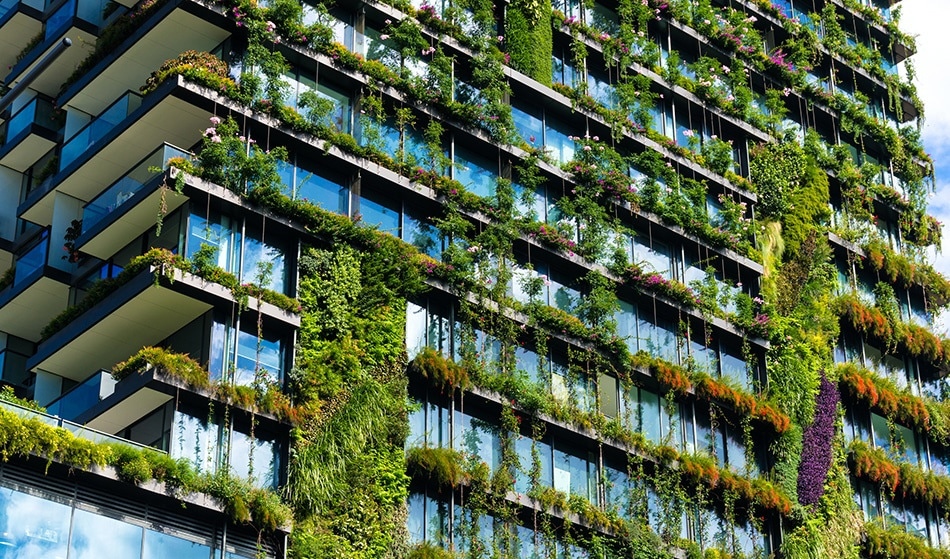
Image Credits: Olga Kashubin/shutterstock.com
There are a multitude of industries and practices that negatively effect the environment, and in recent years the efforts to improve the devastating effects of pollution and waste on the environment have increased significantly, and these efforts extend to the building and construction industry.
Sustainable architecture addresses the negative impacts construction can have on the environment, not only while a building is being constructed, but also once it is being used and lived in.
By reconsidering the materials, methods, energy consumption and spaces in which buildings are constructed, the damage to the environment a building imposes can be greatly reduced. The idea behind sustainable architecture is that the buildings of today do not negatively impact ecosystems and populations in the generations to come.
The ethos supporting sustainable architecture is summed up by architect and industrial designer Enzo Calabrese:
“Sustainability, as a paradox of artifice, poses new issues: confronting the planet democratically is a necessity that brings us straight to the environmental question. […] Human beings consume the Earth’s capital more rapidly compared to nature’s capacity to regenerate itself. A sustainable home doesn’t erode the plant’s bio-capacity, but exists in harmony with it, and is thus able to ‘sustain it’.”
A number of energy-saving and eco-friendly strategies come into play when developing sustainable architecture, a number of which are discussed below.
Sustainable Architecture and Recycling Materials
Many people aim to recycle all materials used in the construction process. It is believed that for a building to be considered highly sustainable, buildings should be modular and able to be deconstructed so that its materials can be used again for other purposes. Recycled building materials can include reclaimed lumber and recycled copper
Sustainable Architecture and Energy Efficiency
A simple way to increase an existing building’s carbon footprint is to ensure that it is well insulated. This will reduce pressure on heating and cooling systems and reduce the consequent pollution.
In new builds, orientating a building to maximize its ability to use natural light or wind, for example, to generate electricity is an excellent way of working with the environment to reduce a building’s long-term environmental impact.
Sustainable Architecture and Building Materials
Earthships Biotecture create houses with zero-energy heating and cooling systems that do not rely on municipal energy sources. Dirt, clay, hay, wood and tires filled with dirt are used as load-bearing wall, and cans and bottles are used to make non-load-bearing walls.
Other good sustainable building materials include:
- Bamboo
- Wheat straw
- Sorghum
- Cork oak
Cities are beginning to change in surprising ways, such as the recent emergence of green walls, in which buildings are covered in wall-climbing plants. Roof gardens have similar benefits to green walls, both having been proven to improve people’s moods, absorb harmful pollutants and contribute to a building’s ability to heat and cool.
Green architecture can also decrease humidity in intensely urbanized areas by absorbing moisture in the air released by road surfaces.
Sustainable Architecture and Waste Management
Disposing of waste materials in construction should not pose any risk to the environment.
Household by-products should also be used to benefit the environment. Systems that use dirty water to sustain plants can be used, as well as toilets that compost sewage and systems to compost food waste directly at the property.
Sustainable Architecture and Old Buildings
Of course, not every sustainable building has to be built from scratch. Older buildings can be upgraded to become more sustainable and reduce their impact on the environment.
Adding solar panels, installing environmentally friendly insulation and modern, low-energy heating and cooling systems can all be used to reduce an old building’s carbon footprint.
Sustainable Architecture and Occupant Health
Using natural building materials can even have positive effects on human health.
For instance, using hempcrete (a building material made from the wooden core of the hemp plant) for insulation and stud walls benefits occupants by eliminating the risk of toxic gases due to its resistance to damp, fungus and pests. Damp in particular poses significant risk to respiratory health and effecting many older buildings.
Summary
Moving towards a more sustainable, environmentally considerate means of construction is incredibly important in an era in which the evidence of climate change and its detrimental affects on every element of the environment is mounting.
There are a huge range of methods to build sustainably, whether it be a new project or an upgrade of an old building. The impacts of sustainable architecture not only benefit the environment and any surrounding ecosystems, but the community and the economy as well.
Sources and Further Reading
Disclaimer: The views expressed here are those of the author expressed in their private capacity and do not necessarily represent the views of AZoM.com Limited T/A AZoNetwork the owner and operator of this website. This disclaimer forms part of the Terms and conditions of use of this website.